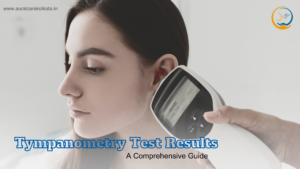Tympanometry serves as a crucial diagnostic tool utilized by medical professionals to evaluate the condition and performance of the middle ear. Grasping the implications of tympanometry test outcomes holds significant importance for both healthcare providers and patients. This comprehensive guide aims to explore the nuances of tympanometry test results, dissecting each parameter to offer a lucid comprehension of their significance.

Introduction to Tympanometry
Before delving into the interpretation of tympanometry test reports or results, it’s pertinent to provide a brief overview of what tympanometry involves. Tympanometry gauges the response of the eardrum to alterations in air pressure. Throughout the examination, a probe is inserted into the ear canal, and air pressure is manipulated while emitting tones through the probe. The resultant graph, known as a tympanogram, furnishes valuable insights into middle ear functionality.
Also Read ↓
Understanding the Components of Tympanometry Test Results
Tympanometry test reports typically include three main parameters:
Peak Pressure (Tympanometry Peak)
- This metric signifies the point of highest compliance of the eardrum, reflecting the pressure at which the middle ear system achieves its most balanced state.
- Optimal peak pressure typically falls within the range of -50 to +50 daPa, indicating normal middle ear function.
- Deviations from this range may indicate conditions such as otitis media or eustachian tube dysfunction.
Compliance
- Compliance, also termed as static acoustic admittance, denotes the eardrum’s mobility in response to air pressure changes.
- Higher compliance implies greater eardrum movement, while lower compliance suggests stiffness or reduced mobility.
- Normal compliance values generally range from 0.3 to 1.5 ml.
Volume (Ear Canal Volume)
This parameter measures the volume of the ear canal, which can reveal abnormalities or the presence of middle ear fluid.
- Ear canal volume refers to the space between the probe tip and the eardrum.
- Normal ear canal volume typically falls between 0.6 to 2.0 ml.
- Abnormal volume levels may indicate issues such as a perforated eardrum or ear canal blockage.
Gradient
- The gradient signifies the rate of compliance change with varying air pressure.
- A steep gradient indicates rapid compliance change, while a flat gradient suggests minimal change.
- Normal gradient values range from 0.3 to 1.5 mmho (millimhos).
Interpreting Tympanometry Assessment Graphs
Tympanometry findings are commonly depicted graphically, with various graph types signaling different conditions:
Type A Graph: This indicates typical middle ear function, considered normal.
Type B Graph: It suggests the presence of fluid in the middle ear or a perforated eardrum.
Type C Graph: This signifies negative middle ear pressure, which can occur due to Eustachian tube dysfunction or otitis media.
Normal Tympanogram (Type A)
A Type A tympanogram demonstrates normal compliance and peak pressure, with a distinct peak denoting optimal middle ear function. This pattern is typically observed in individuals without middle ear issues.
Abnormal Tympanogram Patterns
– Type B Tympanogram
A Type B tympanogram shows reduced compliance with a flat curve, indicating middle ear effusion (fluid buildup), tympanic membrane perforation, or ear canal obstruction.
– Type C Tympanogram
A Type C tympanogram displays normal compliance but with negative peak pressure. This pattern suggests negative middle ear pressure, often linked to Eustachian tube dysfunction or respiratory infections.
– Type As Tympanogram
A Type As tympanogram indicates normal compliance with decreased peak pressure, suggesting tympanic membrane stiffness or ossicular chain fixation.
– Type Ad Tympanogram
A Type Ad tympanogram reveals increased compliance with normal peak pressure, commonly seen in conditions like ossicular discontinuity or middle ear ossicle disruption.
Clinical Significance of Tympanometry Test Results
Understanding the clinical implications of tympanometry test findings is essential for precise diagnosis and proper treatment of ear conditions. Here’s how different parameters of tympanometry are linked to specific ear disorders:
- Middle Ear Inflammation (Otitis Media): Irregular peak compliance and Type B tympanograms are frequently detected in otitis media cases, signaling fluid buildup in the middle ear.
- Eustachian Tube Dysfunction: Type C tympanograms and irregular peak compliance indicate eustachian tube dysfunction, where the middle ear struggles to regulate pressure.
- Otosclerosis: Increased peak compliance and normal ear canal volume may indicate otosclerosis, a condition marked by abnormal bone growth in the middle ear.
The significance of Professional Interpretation
Analyzing tympanometry test outcomes necessitates specialized training and expertise. Audiologists and otolaryngologists have a pivotal role in examining results, making precise diagnoses, and suggesting suitable treatment options based on individual patient requirements.
Read also ↓
The Surprising Truth: How can Tympanometry Trigger Tinnitus?
Guidelines for Patients Regarding Tympanometry Assessment
Patients undergoing tympanometry tests should be mindful of specific guidelines to ensure precise outcomes, such as proper preparation, maintaining stillness during the test, and adhering to any post-test instructions provided by their healthcare provider.
Common Misunderstandings About Tympanometry Test Outcomes or Report
There exist several prevalent misunderstandings regarding tympanometry test reports, including misinterpretation of charts and excessive dependence solely on results for diagnosing ear conditions. It is crucial to dispel these misunderstandings to ensure accurate comprehension among patients and healthcare professionals.
Conclusion
In summary, comprehending the outcomes of tympanometry tests is crucial for precisely diagnosing and addressing a range of ear ailments and issues. Through assessing factors like peak compliance, ear canal volume, and the shape of the tympanogram, medical experts can obtain valuable understanding of the middle ear’s health and performance.
If you’ve recently had a tympanometry test, it’s advisable to confer with your healthcare provider to correctly interpret the findings and explore suitable treatment possibilities. At Aural Care, located in Kolkata, we take pride in offering premier tympanometry testing services. With cutting-edge equipment and expert practitioners, we are committed to prioritizing the health of your ears. Feel confident in choosing Aural Care, renowned as the top tympanometry test clinic in Kolkata, for thorough and dependable assessments.
Your ears deserve nothing but the finest care available!
Schedule your appointment
About Aural Care Kolkata
 Aural Care is the Best Hearing Aid Clinic in Kolkata offering high quality facilities with lots of experienced doctors. We have 15 years experience in this field. Here, we offer the most comprehensive diagnostic facilities and the latest and best technology in hearing aids.
Aural Care is the Best Hearing Aid Clinic in Kolkata offering high quality facilities with lots of experienced doctors. We have 15 years experience in this field. Here, we offer the most comprehensive diagnostic facilities and the latest and best technology in hearing aids.
- Address: GB7, 822, Rajdanga Main Road . Opp. GST Bhawan. Kol 700107
- Phone: +91 98315 37979
- Mail: info@auralcarekolkata.in
Follow us
- Facebook: facebook.com/AuralCareCenterKolkata
- Instagram: instagram.com/auralcarecenter

